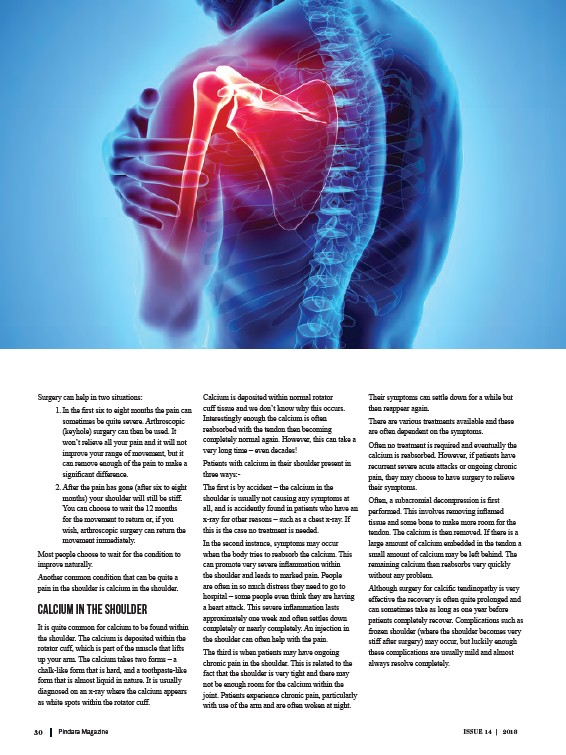
Surgery can help in two situations:
1. In the first six to eight months the pain can
sometimes be quite severe. Arthroscopic
(keyhole) surgery can then be used. It
won’t relieve all your pain and it will not
improve your range of movement, but it
can remove enough of the pain to make a
significant difference.
2. After the pain has gone (after six to eight
months) your shoulder will still be stiff.
You can choose to wait the 12 months
for the movement to return or, if you
wish, arthroscopic surgery can return the
movement immediately.
Most people choose to wait for the condition to
improve naturally.
Another common condition that can be quite a
pain in the shoulder is calcium in the shoulder.
CALCIUM IN THE SHOULDER
It is quite common for calcium to be found within
the shoulder. The calcium is deposited within the
rotator cuff, which is part of the muscle that lifts
up your arm. The calcium takes two forms – a
chalk-like form that is hard, and a toothpaste-like
form that is almost liquid in nature. It is usually
diagnosed on an x-ray where the calcium appears
as white spots within the rotator cuff.
Calcium is deposited within normal rotator
cuff tissue and we don’t know why this occurs.
Interestingly enough the calcium is often
reabsorbed with the tendon then becoming
completely normal again. However, this can take a
very long time – even decades!
Patients with calcium in their shoulder present in
three ways:-
The first is by accident – the calcium in the
shoulder is usually not causing any symptoms at
all, and is accidently found in patients who have an
x-ray for other reasons – such as a chest x-ray. If
this is the case no treatment is needed.
In the second instance, symptoms may occur
when the body tries to reabsorb the calcium. This
can promote very severe inflammation within
the shoulder and leads to marked pain. People
are often in so much distress they need to go to
hospital – some people even think they are having
a heart attack. This severe inflammation lasts
approximately one week and often settles down
completely or nearly completely. An injection in
the shoulder can often help with the pain.
The third is when patients may have ongoing
chronic pain in the shoulder. This is related to the
fact that the shoulder is very tight and there may
not be enough room for the calcium within the
joint. Patients experience chronic pain, particularly
with use of the arm and are often woken at night.
Their symptoms can settle down for a while but
then reappear again.
There are various treatments available and these
are often dependent on the symptoms.
Often no treatment is required and eventually the
calcium is reabsorbed. However, if patients have
recurrent severe acute attacks or ongoing chronic
pain, they may choose to have surgery to relieve
their symptoms.
Often, a subacromial decompression is first
performed. This involves removing inflamed
tissue and some bone to make more room for the
tendon. The calcium is then removed. If there is a
large amount of calcium embedded in the tendon a
small amount of calcium may be left behind. The
remaining calcium then reabsorbs very quickly
without any problem.
Although surgery for calcific tendinopathy is very
effective the recovery is often quite prolonged and
can sometimes take as long as one year before
patients completely recover. Complications such as
frozen shoulder (where the shoulder becomes very
stiff after surgery) may occur, but luckily enough
these complications are usually mild and almost
always resolve completely.
30 Pindara Magazine ISSUE 14 | 2018